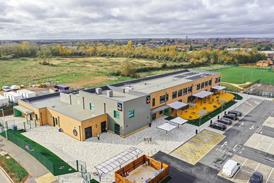1: THE RIGHT DESIGN
Client and Contractor – Forming Partnerships that Work
Until recently, the security industry tended to be a fairly small player in most projects, with the security professional usually acting as a minor sub-contractor to the electrical installer. This often meant a hasty phone call a few days before handover requesting an immediate start and an even faster finish.
Now things are changing and security installers are having to adapt to a new role, becoming one of the major players in many projects. The client needs to know that the security installer fully understands the client's needs.
Practicality of design must also play a key role in the early planning stages. Cutting corners to reduce costs can waste far larger amounts of money over the life of the system. Long-term reliability does not always come from the installer offering the lowest tender. However, savings can be made through close liaison between client and contractor at the planning stage.
Health and Safety
The installer must be able to meet the responsibilities that the role brings. These include not least health and safety, a vital area for both contractor and client.
Until recently the contracting industry had a poor record on safety. This has improved considerably, thanks in no small part to the CDM regulations that give a shared responsibility for safety to both the contractor and the client.
Similarly, the environment has in the past received scant attention and at best lip service from industry in general. Environmental damage can be very costly. Both contractor and client need to treat it in the same way as health and safety, pro-actively using the same risk analysis techniques.
For example, LE Security Systems recently installed a large number of cameras and security lighting columns in a park close to central London. This involved nearly two miles of trenching in addition to excavating the lighting and camera column bases. LE Security Systems spent as long planning the cable route for our civils team as in agreeing the camera positions, in order to avoid any permanent damage to the roots of the many trees in the park.
Best Value/Present and Future Requirements
Best value also means planning for future system expansion. In the past, if a company wanted to add a few extra zones to an intruder alarm or some more handsets to an entryphone, or maybe a couple of extra cameras for the CCTV system, the installer would probably say "sorry, no more capacity – you'll need a new controller costing you considerably more money". In contrast, LE Security Systems offers a complete service, assessing the client's future needs in the planning stages.
2: SYSTEM INSTALLATION
Once the project manager has a clear set of instructions he can carry out his task professionally and to the satisfaction of all. If Step 1 is conducted professionally, the installation phase is a lot easier.
The project manager's role is to deliver the project on time and within budget. Using skills in communication and planning, his role is to act as the key contact with the client and the equipment suppliers as well as co-ordinating all the other trades involved within the works.
The project manager must also be able to adapt to the client's changing needs as the client may add and omit during the implementation phase.
Resourcing sufficient levels of skilled labour is a major headache on any large project. A company is only as good as the people it employs. Companies should invest in the industry's future by training staff. LE Security Systems believes it has demonstrated its commitment to training by being awarded the Investor in People accreditation.
3:TEST AND COMMISSION
Handover procedures vary enormously from installer to installer, although with intruder alarms, the procedures are highly regulated.
Unfortunately, the same cannot be said of access control or CCTV. The regulation of the intruder alarm sector was driven by the insurance industry through the ABI (Association of British Insurers). There is no-one driving to regulate either CCTV or access control in the same way. Considering that access control is projected to turn over £207m and CCTV £471m this year, and with growth rates at around seven per cent combined, these are now a bigger market than intruder alarms.
The way forward may be to take NACP20 and NACP30 as the benchmarks for the installation and maintenance of CCTV and access control systems. Both documents are produced by NACOSS and have had input from most sectors of the industry.
The adoption of these 'standards' would eventually lead to the same level of quality and professionalism enjoyed in the intruder alarm sector. LE Security Systems has already adopted NACP20 and NACP30 to ensure that we can deliver the installation and maintenance of CCTV and access control systems to the same high standards as with intruder alarms.
It is essential that the client is given a comprehensive handover, so that he feels comfortable with what has been installed and knows exactly what he has bought and how it works.
Additionally, full and detailed documentation must always be provided as part of the handover procedure. This documents the system installed and is vital for the system's operation, maintenance and future upgradability.
4: USER TRAINING
So that the client fully understands how it works, user training should be given to all those people who will use the system on a day-to-day basis. Refresher training should also be given after the initial training to ensure that the client gets the maximum benefit from what has been installed.
5: SYSTEM SUPPORT
The quality of the ongoing service is equally as important as the installation. Service technicians must be adequately trained to offer a comprehensive solution within a quick response time. It is no good responding quickly if the service technician does not understand the equipment. The client does not want to hear comments like "I haven't seen one of those before" or "I didn't know they did that" or "Who sold you that then?" LE Security Systems partners with key equipment suppliers to ensure system reliability. They provide regular refresher training for support staff to ensure that when they are called out they can provide an effective solution.
By adopting a professional approach in each of the five key steps, LE Security Systems offers a comprehensive design, installation and support service that clients can rely on.
Source
Security Installer




















